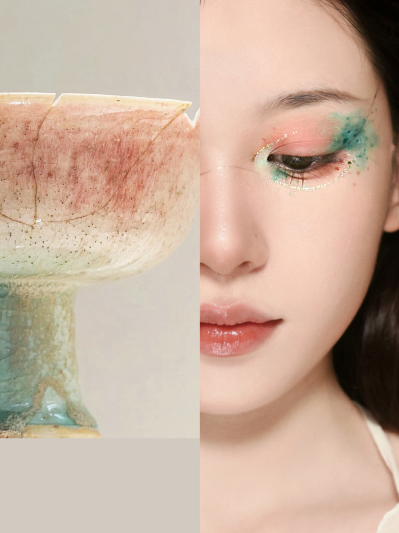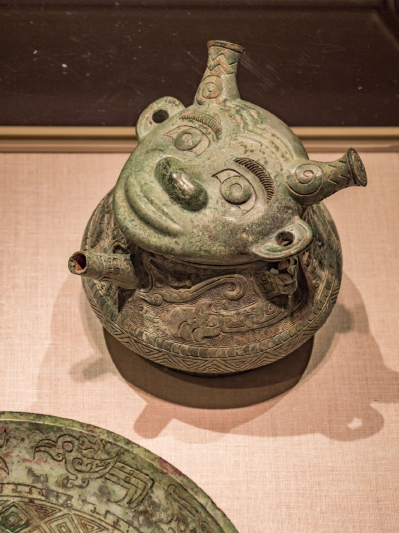Creative young minds illuminate the living tales of museums

Rainie Huang's makeup, inspired by a porcelain piece from the Hangzhou Museum, Zhejiang Province (COURTESY PHOTO)
In its cyan expanse, one finds the essence of clouds dissipating after a refreshing rain, while in its blush hues, the spirit of riverbank maple leaves in their vibrant grace—this is a poetic description given by a netizen to a porcelain cup from the Yuan Dynasty (1279-1368). When bathed in the soft glow of ambient light, the cup glistens with a captivating luminosity. The exquisite harmony of these contrasting colors is reminiscent of a crisp spring day.
Due to its intricate glazing technique, known as underglaze red, and remarkably low success rate, porcelain of this style was once hailed as a gem of ceramic art. Sitting for years on a display rack at the Hangzhou Museum in Zhejiang Province, the sleeping beauty was recently awakened by Rainie Huang's bewitching magic. Huang, a makeup artist, has used this masterpiece of visual poetry as inspiration for a collection of makeup looks.
In her creative makeup, the fusion of cyan and blush shades is a breathtaking sight, mirroring the texture of the artifact flawlessly with the perfect blend of eyeshadow and foundation. Even the imperfections from the porcelain's surface are vividly recreated on her face, achieving a true-to-life interpretation. The innovation has garnered extensive attention on social media. To date, Huang's artifact-inspired makeup posts have received more than 1 million views.
"Through the makeup, I aspire to bring the often distant world of historical artifacts closer to young people in a more accessible and relatable way," the 26-year-old Huang told Beijing Review. "By presenting the beauty in an easy manner and integrating it into people's fragmented moments of leisure, perhaps we can shatter the barriers that often separate these cultural relics from our daily lives."
Unbridled imagination
Huang's journey in makeup artistry began in 2018, during the peak of the Story of Yanxi Palace craze. While pursuing a fashion design degree at an art academy, she discovered her passion for makeup in her free moments. Intrigued by the costume TV drama series, set in the Qing Dynasty (1644-1911), she decided to hone her makeup skills by transforming herself into its characters. Sharing her creations on Weibo, a major micro-blogging platform in China, her talent quickly captured the spotlight.
In 2020, "the Palace Museum covered in snow" became a trending topic on social media. "It was my first time witnessing such a scene. An idea came upon me then: Were those cultural relics quietly appreciating the snowy spectacle inside the palace?" Huang said.
This time, instead of portraying characters from dramas, she began envisioning what the relics might look like in human form. So she extracted colors and elements from these artifacts for her designs and made her first foray into museum relic-inspired creative makeup. Its novelty quickly gained popularity. "This approach not only allows people to appreciate the creativity of makeup but also helps them connect with the vitality of our cultural heritage," Huang said.
Some of her followers voluntarily seek out cultural relics for her, and some have expressed how her makeup designs have introduced them to many previously little known artifacts. One of them, with the username Manchi, commented, "You have picked the gems from the museums for us, allowing the relics, once lost in the overwhelming array of exhibits during our hurried visits, to be seen and appreciated closely."
In recent years, museums have witnessed a growing fascination among the younger generation. According to the National Cultural Heritage Administration (NCHA), museums nationwide received a total of 1.631 million visitors in 2022, with over 50 percent of them being under the age of 35.
Apart from visiting museums, influencers like Huang are actively spreading museum culture through innovative approaches, taking China's current museum craze to new heights. "It's essential for the ways culture is passed on to keep pace with the changing times to avoid culture loss and disruption," Huang said.
Seven-Point Sweet Mackerel, the online nickname of a young vlogger who focuses on developing creative cuisine, is another example. Her Sanxingdui Museum-themed afternoon tea service wowed her audience as soon as it debuted. The museum in Guanghan, Sichuan Province, houses relics unearthed from the renowned Sanxingdui Ruins, the remnants of the ancient Shu Kingdom, which had its heyday around 3,000 years ago.
She created a variety of desserts in the style of collections of the museum, including a bronze figurine-shaped cake roll, a mask-shaped macaron and a sun-wheel shaped matcha cake. The items were placed under a larger peach blossom tree made of chocolate. To add interactive fun, she created edible soil using chocolate cake crumbs under the tree for diners to excavate, providing them with the joy of archaeological digging.
"It is the most vivid combination of Chinese culture and dessert," a follower with the username fishfish commented.
XD on the Way (hereinafter XD), a social media account on lifestyle app Xiaohongshu (Little Red Book), takes an alternative approach. Xi Lei, one of the two operators of XD, has a knack for sharing the little known stories behind cultural artifacts in a humorous language. For instance, he once explained why the Palace Museum in Beijing, which houses the imperial palace from the 15th century to the early 20th century, had collected three counterfeits of a bronzeware face from the Shang Dynasty (1600-1046 B.C.) that resembles the animated character Shrek, while the authentic artifact is on display in a U.S. museum. The post has received many likes and comments.
The XD account began with a travel experience of Xi Lei in Shanxi Province, where ancient buildings are scattered throughout villages, and their histories are shrouded in obscurity. Documented information about these relics was scarce, and the most intriguing anecdotes often came from conversations with local elderly residents. He began researching the ancient buildings, both from oral accounts and in literature, unearthing records hidden within the annals of history and sharing them online.
Through this endeavor, Xi Lei began to uncover the mysteries of the world of cultural artifacts. His "background investigation" on artifacts gradually expanded the account's focus from local relics to those lost overseas. The stories behind these artifacts, coupled with the operators' personally captured rare images of these items, have captivated a wide audience.

Growing confidence
While young people are broadening the scope of museum culture, museums, on the other side, are serving as both treasure troves and wellsprings of inspiration for curious visitors. According to the NCHA, the total number of Chinese museums nationwide reached 6,565 in 2022, ranking among the top in the world.
"China's millennia-old civilization has bestowed upon the world a truly unparalleled culture and aesthetic. The craftsmanship and techniques found in many historical artifacts continue to astonish even in our modern era, and this invaluable cultural legacy must not be discarded or forgotten," Huang said, stressing that young generations are responsible for carrying forward the Chinese culture, in whatever positive and constructive manners.
Huang has noticed that an increasing number of young individuals showing a heightened appreciation for traditional culture. This curiosity is motivating many to frequent museums. "I'm a museum enthusiast myself, and the deeper I delve into these museums, the more my confidence in our remarkable culture and civilization grows," she said.
Huang credits the collective cultural confidence to a diverse array of channels for learning about Chinese culture and the country's rising overall strength. Xi Lei shares Huang's opinion. "I believe economic development is the key factor here. Once people have their basic needs met, they naturally have higher intellectual and cultural aspirations," he told Beijing Review.
Xi Lei said he can sense a change in people's attitudes toward museums. In the past, many considered museum visits tedious because of a lack of awareness of their wealth of collections. The recommendations by social media influencers and TV programs dedicated to culture and history have led to an increasing number of individuals realizing that museums offer a multitude of captivating elements. "While not everyone may be passionate about archaeology and history, the quest for beauty is inherent among people," he said.
From his perspective, the aesthetic appeal of artifacts seems to resonate more with his followers because of the nature of platforms like Xiaohongshu, where users are initially drawn by the artistic qualities. Xi Lei said his original intent was simply to share appealing photos taken during his travels, and the accompanying research, with those who were interested. If the actions have any effect, it's in making others become aware of the charm of museums and sparking a desire to explore it—a promising beginning in his view. BR
Related articles
-
 Wuzhen festival in full flow
Wuzhen festival in full flowMore
-
 Chinese tea culture-themed exhibition opens in Budapest, Hungary
Chinese tea culture-themed exhibition opens in Budapest, HungaryMore
-
 Journey to fulfillment
Journey to fulfillmentMore
-
 Shanghai exhibition showcases best of young artists
Shanghai exhibition showcases best of young artistsMore
-
 A painter wins popularity on short video platforms by freeze-framing heartwarming moments
A painter wins popularity on short video platforms by freeze-framing heartwarming momentsMore
-
 Chagan Lake Winter Fishing: A Millennium-Old Tradition
Chagan Lake Winter Fishing: A Millennium-Old TraditionMore
